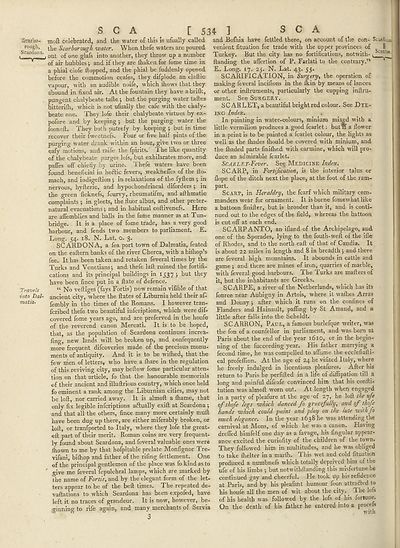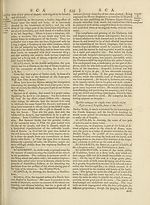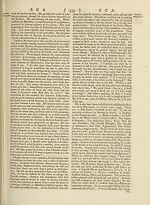Encyclopaedia Britannica, or, a Dictionary of arts, sciences, and miscellaneous literature : enlarged and improved. Illustrated with nearly six hundred engravings > Volume 18, RHI-SCR
(556) Page 534
Download files
Complete book:
Individual page:
Thumbnail gallery: Grid view | List view

S C A [ 53+ ] S C A
Scarbo- rnoft celebrated, and the water of this is ufually called
rough, t]ie Scarborough water. When thefe waters are poured
Seaniona. ^ ^ ^ giafs into another, they throw up a number
, of air bubbles j and if they are fhaken for fome time in
a phial clofe flopped, and the phial be fuddenly opened
before the commotion ceafes, they difplode an elaftic
vapour, with an audible noife, which fliows that they
abound in fixed air. At the fountain they have a brifk,
pungent chalybeate tafte; but the purging water taftes
bitterifli, which is not ufually the cafe with the chaly¬
beate one. They lufe their chalybeate virtues by ex-
pofure and by keeping ; but the purging v'ater the
fooneft. They both putrefy by keeping *, but in time
recover their fweetnefs. Four or five half pints of the
purging water drank within an hour, give two or three
eafy motions, and raife the fpirits. J. he like quantity
of the chalybeate purges lefs, but exhilarates more, and
pafles oft' chiefly by urine. Thefe waters have been
found beneficial in hectic fevers, weakheffes of the fto-
mach, and indigeftion *, in relaxations of the fyftem *, in
nervous, hyfteric, and hypochondriacal diforders ; in
the green ficknefs, fcurvy, rheumatifm, and afthmatic
complaints j in gleets, the fluor albus, and other preter¬
natural evacuations j and in habitual coftivenefs. Here
are affemblies and balls in the fame manner as at Tun¬
bridge. It is a place of fome trade, has a very good
harbour, and fends two members to parliament. E.
Long. 54. 18. N. Lat. o. 3.
S CARD ON A, a fea port town of Dalmatia, feated
on the eaftern banks of the river Cherca, with a bifliop’s
fee. It has been taken and retaken feveral times by the
Turks and Venetians •, and thefe laft ruined the fortifi¬
cations and its principal buildings in 1537 J but they
have been fince put in a ftate of defence.
Travels “ No veftiges (fays Fortis) now remain vifible of that
■i/ito Dal- ancient city, where the ftates of Liburnia held their af-
matia. fembly in the times of the Romans. I however tran-
fcribed thefe two beautiful infcriptions, which were dif-
covered fome years ago, and are preferved in the houfe
of the reverend canon Mercati. It is to be hoped,
that, as the population of Scardona continues increa-
fing, new lands will be broken up, and confequently
more frequent difcoveries made of the precious monu¬
ments of antiquity. And it is to be wilhed, that the
few men of letters, who have a lhare in the regulation
of this reviving city, may beftow fome particular atten¬
tion on that article, fo that the honourable memorials
of their ancient and illuftrious country, which once held
fo eminent a rank among the Liburnian cities, may not
be loft, nor carried away. It is almoft a ftiame, that
only fix legible infcriptions a6tually exift at Scardona;
and that all the others, fince many more certainly muft
have been dug up there, are either miferably broken, or
loft, or tranfported to Italy, where they lofe the great-
eft part of their merit. Roman coins are very frequent¬
ly found about Scardona, and feveral valuable ones w^ere
ihown to me by that hofpitable prelate Monfignor Tre-
vifani, bilhop and father of the rifing fettlement. One
of the principal gentlemen of the place vTas fo kind as to
give me feveral fepulchral lamps, which are marked by
the name of Fortis, and by the elegant form of the let¬
ters appear to be of the beft times. The repeated de-
vaftations to Avhich Scardona has been expofed, have
left it no traces of grandeur. It is now, however, be¬
ginning to rife again, and many merchants of Servia
3
and Bofnia have fettled there, on account of the con- ScarJ. .,aii
venient fituation for trade with the upper provinces of II
Turkey. But the city has no fortifications, notwith- , carroti
Handing the aftertion of P. Farlati to the contrary.1’
E. Long. 17. 25. N. Lat. 43. 55.
SCARIFICATION, in Surgery, the operation of
making feveral incifions in the Ikin by means of lances
or other inftruments, particularly the cupping inftru-
ment. See SuRGERY.
SC ARLET, a beautiful bright red colour. See Dye¬
ing Index.
In painting in water-colours, minium mixed with a
little vermilion produces a good fcarlet: butff a flower
in a print is to be painted a fcarlet colour, the lights as
well as the fhades Ihould be covered with minium, and
the lhaded parts finilhed with carmine, which will pro¬
duce an admirable fcarlet.
SCARLET-Fever. See Medicine Index.
SCARP, in Fortification, is the interior talus or
Hope of the ditch next the place, at the foot of the ram¬
part.
SCARP, in Heraldry, the fcarf which military com¬
manders wear for ornament. It is borne fomewhatlike
a battoon finifter, but is broader than it, and is conti¬
nued out to the edges of the field, whereas the battoon
is cut off at each end.
SCARPANTO, an illand of the Archipelago, and
one of the Sporades, lying to the fouth-weft of the ille
of Rhodes, and to the north eaft of that of Candia. It
is about 22 miles in length and 8 in breadth \ and there
are feveral high mountains. It abounds in cattle and
game ; and there are mines of iron, quarries of marble,
with feveral good harbours. The Turks are mafters of
it, but the inhabitants are Greeks.
SCARPE, a river of the Netherlands, which has its
fouree near Aubigny in Artois, where it wafhes Arras
and Douay j after which it runs on the confines of
Flanders and Hainault, palling by St Amand, and a
little after falls into the Scheldt.
SCARRON, Paul, a famous burlefque writer, w'as
the fon of a counfellor in parliament, and was born at
Paris about the end of the year 1610, or in the begin¬
ning of the fucceeding year. His father marrying a
fecond time, he was compelled to affume the ecclefiafti-
cal profeflion. At the age of 24 he vifited Italy, where
he freely indulged in licentious pleafures. After his
return to Paris he perfifted in a life of diffipation till a
long and painful difeafe convinced him that his confti-
tution was almoft worn out. At length when engaged
in a party of pleafure at the age of 27, he loft the ufe
of thofe legs which danced fo gracefully, and of tlwfe
hands which could paint and play on the lute with fa
much elegance. In the year 1638116 was attending the
carnival at Mons, of which he was a canon. Having
drefled bimfelf one day as a favage, his Angular appear¬
ance excited the curiofity of the children of the town.
They followed him in multitudes, and he was obliged
to take ftielter in a marlh. This wet and cold fituation
produced a numbnefs which totally deprived him of the
ufe of his limbs; but notwithftanding this misfortune he
continued gay and cheerful. He took up his refidence
at Paris, and by his pleafant humour foon attracted to
his houfe all the men of wit about the city.. The lols
of his health was followed by the lofs of his fortune.
On the death of his father he entered into a procefs
with
Scarbo- rnoft celebrated, and the water of this is ufually called
rough, t]ie Scarborough water. When thefe waters are poured
Seaniona. ^ ^ ^ giafs into another, they throw up a number
, of air bubbles j and if they are fhaken for fome time in
a phial clofe flopped, and the phial be fuddenly opened
before the commotion ceafes, they difplode an elaftic
vapour, with an audible noife, which fliows that they
abound in fixed air. At the fountain they have a brifk,
pungent chalybeate tafte; but the purging water taftes
bitterifli, which is not ufually the cafe with the chaly¬
beate one. They lufe their chalybeate virtues by ex-
pofure and by keeping ; but the purging v'ater the
fooneft. They both putrefy by keeping *, but in time
recover their fweetnefs. Four or five half pints of the
purging water drank within an hour, give two or three
eafy motions, and raife the fpirits. J. he like quantity
of the chalybeate purges lefs, but exhilarates more, and
pafles oft' chiefly by urine. Thefe waters have been
found beneficial in hectic fevers, weakheffes of the fto-
mach, and indigeftion *, in relaxations of the fyftem *, in
nervous, hyfteric, and hypochondriacal diforders ; in
the green ficknefs, fcurvy, rheumatifm, and afthmatic
complaints j in gleets, the fluor albus, and other preter¬
natural evacuations j and in habitual coftivenefs. Here
are affemblies and balls in the fame manner as at Tun¬
bridge. It is a place of fome trade, has a very good
harbour, and fends two members to parliament. E.
Long. 54. 18. N. Lat. o. 3.
S CARD ON A, a fea port town of Dalmatia, feated
on the eaftern banks of the river Cherca, with a bifliop’s
fee. It has been taken and retaken feveral times by the
Turks and Venetians •, and thefe laft ruined the fortifi¬
cations and its principal buildings in 1537 J but they
have been fince put in a ftate of defence.
Travels “ No veftiges (fays Fortis) now remain vifible of that
■i/ito Dal- ancient city, where the ftates of Liburnia held their af-
matia. fembly in the times of the Romans. I however tran-
fcribed thefe two beautiful infcriptions, which were dif-
covered fome years ago, and are preferved in the houfe
of the reverend canon Mercati. It is to be hoped,
that, as the population of Scardona continues increa-
fing, new lands will be broken up, and confequently
more frequent difcoveries made of the precious monu¬
ments of antiquity. And it is to be wilhed, that the
few men of letters, who have a lhare in the regulation
of this reviving city, may beftow fome particular atten¬
tion on that article, fo that the honourable memorials
of their ancient and illuftrious country, which once held
fo eminent a rank among the Liburnian cities, may not
be loft, nor carried away. It is almoft a ftiame, that
only fix legible infcriptions a6tually exift at Scardona;
and that all the others, fince many more certainly muft
have been dug up there, are either miferably broken, or
loft, or tranfported to Italy, where they lofe the great-
eft part of their merit. Roman coins are very frequent¬
ly found about Scardona, and feveral valuable ones w^ere
ihown to me by that hofpitable prelate Monfignor Tre-
vifani, bilhop and father of the rifing fettlement. One
of the principal gentlemen of the place vTas fo kind as to
give me feveral fepulchral lamps, which are marked by
the name of Fortis, and by the elegant form of the let¬
ters appear to be of the beft times. The repeated de-
vaftations to Avhich Scardona has been expofed, have
left it no traces of grandeur. It is now, however, be¬
ginning to rife again, and many merchants of Servia
3
and Bofnia have fettled there, on account of the con- ScarJ. .,aii
venient fituation for trade with the upper provinces of II
Turkey. But the city has no fortifications, notwith- , carroti
Handing the aftertion of P. Farlati to the contrary.1’
E. Long. 17. 25. N. Lat. 43. 55.
SCARIFICATION, in Surgery, the operation of
making feveral incifions in the Ikin by means of lances
or other inftruments, particularly the cupping inftru-
ment. See SuRGERY.
SC ARLET, a beautiful bright red colour. See Dye¬
ing Index.
In painting in water-colours, minium mixed with a
little vermilion produces a good fcarlet: butff a flower
in a print is to be painted a fcarlet colour, the lights as
well as the fhades Ihould be covered with minium, and
the lhaded parts finilhed with carmine, which will pro¬
duce an admirable fcarlet.
SCARLET-Fever. See Medicine Index.
SCARP, in Fortification, is the interior talus or
Hope of the ditch next the place, at the foot of the ram¬
part.
SCARP, in Heraldry, the fcarf which military com¬
manders wear for ornament. It is borne fomewhatlike
a battoon finifter, but is broader than it, and is conti¬
nued out to the edges of the field, whereas the battoon
is cut off at each end.
SCARPANTO, an illand of the Archipelago, and
one of the Sporades, lying to the fouth-weft of the ille
of Rhodes, and to the north eaft of that of Candia. It
is about 22 miles in length and 8 in breadth \ and there
are feveral high mountains. It abounds in cattle and
game ; and there are mines of iron, quarries of marble,
with feveral good harbours. The Turks are mafters of
it, but the inhabitants are Greeks.
SCARPE, a river of the Netherlands, which has its
fouree near Aubigny in Artois, where it wafhes Arras
and Douay j after which it runs on the confines of
Flanders and Hainault, palling by St Amand, and a
little after falls into the Scheldt.
SCARRON, Paul, a famous burlefque writer, w'as
the fon of a counfellor in parliament, and was born at
Paris about the end of the year 1610, or in the begin¬
ning of the fucceeding year. His father marrying a
fecond time, he was compelled to affume the ecclefiafti-
cal profeflion. At the age of 24 he vifited Italy, where
he freely indulged in licentious pleafures. After his
return to Paris he perfifted in a life of diffipation till a
long and painful difeafe convinced him that his confti-
tution was almoft worn out. At length when engaged
in a party of pleafure at the age of 27, he loft the ufe
of thofe legs which danced fo gracefully, and of tlwfe
hands which could paint and play on the lute with fa
much elegance. In the year 1638116 was attending the
carnival at Mons, of which he was a canon. Having
drefled bimfelf one day as a favage, his Angular appear¬
ance excited the curiofity of the children of the town.
They followed him in multitudes, and he was obliged
to take ftielter in a marlh. This wet and cold fituation
produced a numbnefs which totally deprived him of the
ufe of his limbs; but notwithftanding this misfortune he
continued gay and cheerful. He took up his refidence
at Paris, and by his pleafant humour foon attracted to
his houfe all the men of wit about the city.. The lols
of his health was followed by the lofs of his fortune.
On the death of his father he entered into a procefs
with
Set display mode to:
![]() Universal Viewer |
Universal Viewer | ![]() Mirador |
Large image | Transcription
Mirador |
Large image | Transcription
Images and transcriptions on this page, including medium image downloads, may be used under the Creative Commons Attribution 4.0 International Licence unless otherwise stated. ![]()
| Permanent URL | https://digital.nls.uk/193025935 |
|---|
| Attribution and copyright: |
|
|---|
| Description | Ten editions of 'Encyclopaedia Britannica', issued from 1768-1903, in 231 volumes. Originally issued in 100 weekly parts (3 volumes) between 1768 and 1771 by publishers: Colin Macfarquhar and Andrew Bell (Edinburgh); editor: William Smellie: engraver: Andrew Bell. Expanded editions in the 19th century featured more volumes and contributions from leading experts in their fields. Managed and published in Edinburgh up to the 9th edition (25 volumes, from 1875-1889); the 10th edition (1902-1903) re-issued the 9th edition, with 11 supplementary volumes. |
|---|---|
| Additional NLS resources: |
|

